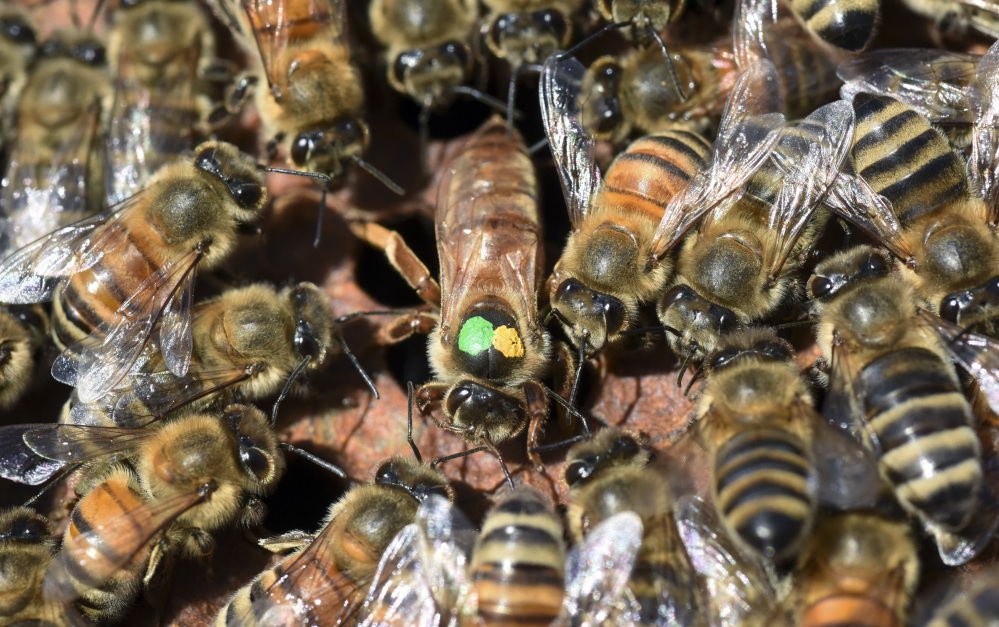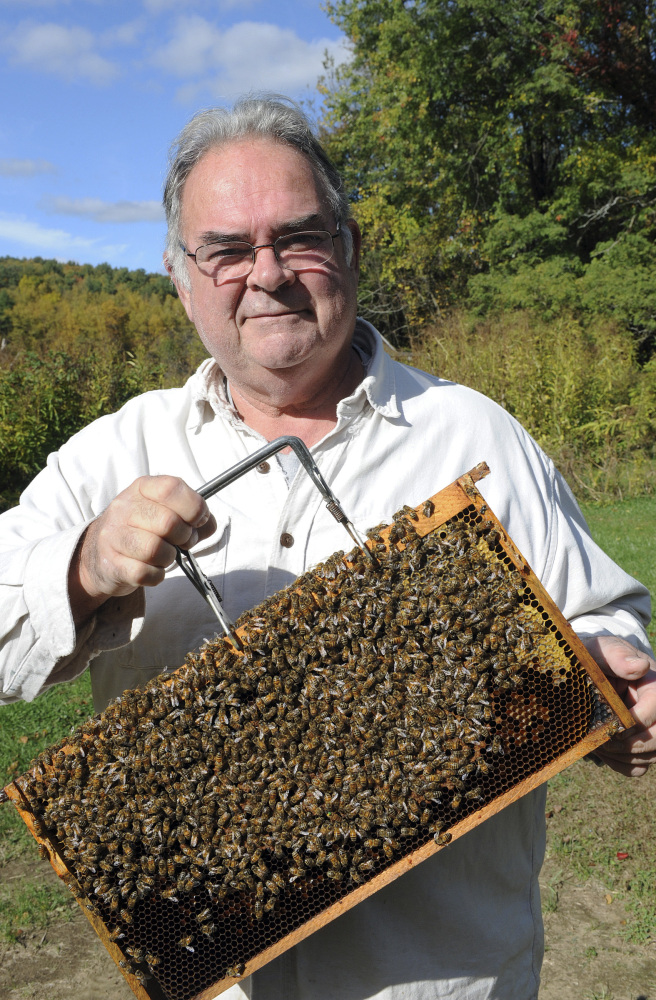DEERFIELD, Mass. — It was the early 1990s and America’s honeybees were under attack.
Dan Conlon, owner of Warm Colors Apiary in Deerfield, watched as hive after hive of his fellow beekeeper’s stock succumbed to the Varroa destructor, a parasitic mite against which European bees are virtually defenseless.
The mites, which Conlon said are native to Asia and had probably entered the U.S. as stowaways on a shipment of bees, had launched a full-scale invasion that decimated hives across the country and drove many professional beekeepers into bankruptcy. In just three years, he said, the country lost over 4 million beehives.
“Before we even knew they existed, they had already spread everywhere. In about six months, it was over before anything could be done,” said Conlon. “They were so destructive that we dropped from 6 million hives to under 2 million in three years. Even today, we’ve only got about 2.4 million.”
In a desperate attempt to end the crisis, Conlon said, many beekeepers found themselves resorting to pesticide use to kill the mites – a decision that also had detrimental effects on the bees’ health.
Today, Conlon said, the mite invasion and those practices have become two of the prime suspects in identifying the causes of Colony Collapse Disorder, a recent phenomenon in which entire hive populations vanish without a trace.
When the beekeepers began using chemicals against the mites, Conlon said, they deviated from thousands of years of beekeeping tradition that used natural selection and selective breeding to strengthen bees against diseases, weather and pests. Eventually, the mites became resistant to the pesticides.
“That period changed beekeeping forever,” he said. “The U.S. used to be a surplus producer of honey, but now we import almost 70 percent of it.”
But Conlon, along with a handful of other beekeepers and scientists, has found a way to fight back. Enter the Russian honey bee.
NATURAL DEFENSES AGAINST MITES
As a member of the Russian Honey Bee Breeders Association, Conlon began introducing honey bees from Russia’s Primorsky region into his hives 14 years ago. The Russian bees, which are from the same area as the mites, have developed a natural defense against them: They groom each other, removing the bugs and tossing them out of their hives – a behavior which their European cousins don’t exhibit.
But the adult bees aren’t the only ones threatened by the mites. During the pupal stage – the period in which a bee transitions from a larva into an adult – the mites force their way into the cells and try to eat the pupa.
According to Condon, the Russian bees have developed a way to sense when that is occurring and are able to pull those mites out as well.
“In nature, a lot of these mechanisms appear over long periods of time, and some have these abilities that help them survive,” said Condon. “It’s probably the best solution yet, it’s very exciting. They’re hardier bees. Eventually there won’t be any treatment necessary.”
Condon said the idea of using the Russian bees to fight the mite problems was first conceived by Dr. Tom Rinderer, of the United States Department of Agriculture. Rinderer noticed the unique behavior of the bees and after about eight years of negotiations with the U.S. and Russian governments was able to obtain a few queens, which he brought to an island near Baton Rouge, Louisiana, to be tested under quarantine.
Rinderer found that the anti-mite behavior was a genetic trait and began breeding the bees to introduce the trait to other species.
“He sped up natural selection,” said Condon. “He picked the bees where the trait was strongest and amplified the genetics. We’ve actually improved the stock.”
Condon said Rinderer identified 18 distinct genetic lines within the Russian honey bee population that had the desirable traits and began breeding them. Each of the association’s members, which Condon said includes about 10 people, are responsible for maintaining two of the lines.
ENSURING PURITY OF THE LINES
But ensuring the purity of the lines is no easy task. When mating, Condon said, the bees can fly miles from their hives and the process occurs in midair. To be sure that the Russian queens are mating with Russian drones, Condon has to saturate the area with them.
“The Queens can mate with up to a dozen drones in their lifetime,” said Condon. “If you have other types of bees in there, it will dilute the stock.”
He said all 800 of his hives are now filled with Russian bees.
To be sure the lines have remained pure, Condon has to send DNA samples to the association for testing. He said he expects to hear the results of his most recent sampling within the next few weeks.
Condon, who has 45 years of beekeeping experience, said he began breeding Russian bees about 14 years ago. He’s been an official association member for five years.
Before making the switch, he raised his bees in an open system where they were allowed to mate with other types to produce “hybrid vigor,” resulting in hardier, more prolific bees.
“It worked well for a number of years, but there’s very little control and it becomes inconsistent,” he said. “After about two to three years, we’d lose the initial genetics and it would go in the other direction.”
Raising the Russian bees, he said, is much more regimented.
“It needs to be predictable to ensure purity in the lines,” Condon said.
Condon said the association’s long-term goal is to show people that bees can be created with the ability to solve their own problems.
Send questions/comments to the editors.




Success. Please wait for the page to reload. If the page does not reload within 5 seconds, please refresh the page.
Enter your email and password to access comments.
Hi, to comment on stories you must . This profile is in addition to your subscription and website login.
Already have a commenting profile? .
Invalid username/password.
Please check your email to confirm and complete your registration.
Only subscribers are eligible to post comments. Please subscribe or login first for digital access. Here’s why.
Use the form below to reset your password. When you've submitted your account email, we will send an email with a reset code.